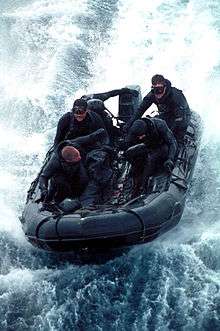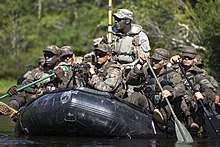Combat Rubber Raiding Craft
The Wing P4.7 Combat Rubber Raiding Craft (CRRC), [1]also known as the "Combat Rubber Reconnaissance Craft," is a rigid inflatable boat fabricated from Cooley Coolthane polyurethane fabric and is currently in operation with the U.S. Navy, U.S. Marine Corps, the U.S. Army, NASA and others.[2] [3]


Function
The boat can be used for over-the-horizon transportation, inserting lightly armed raiding parties or reconnaissance teams onto beaches, piers, offshore facilities and larger vessels. The CRRC can be inflated in minutes by foot pump, compressor or CO2 tank and can be deployed from shore and a variety of vessels. Additionally, it can be launched from several types of aircraft and submarines equipped with a special lockout chamber or a Dry Deck Shelter. Its chief advantages are light weight, compact size when stowed, stealth, versatility, and the safety imparted by its super-buoyant nature (which gives it the ability to operate in relatively high seas).
A total of six individual airtight chambers comprise the Wing P4.7. The main hull or gunwale contains five intercommunicating chambers, which are separated by internal baffles and valves. This means that a single leak will not result in loss of pressure throughout the boat, and that air can be bled between chambers to compensate for loss in one. The final chamber is an inflatable keel tube which runs the length of the craft and gives the bottom of the hull a "V" shape, imparting directional stability and additional shock absorption. A composite decay proof "transom" board at the stern provides a mounting point for the outboard engine(s) . The deck (floor) is composed of four interlocking composite plates, which are fixed to the "thrust board" at the bow end and the transom at the stern. This rigid structure, spanning the entire internal area of the boat, prevents the hull from collapsing or "taco-ing" under power.
A ready-for-use craft includes an outboard engine (two in some configurations); removable composite deckplates or roll-up slatted decking; paddles; a bow line for securing the docked boat and a "righting" line which is used to flip the boat in the event of capsizing. At the bow of the boat are storage bags for equipment (foot pumps, extra lines, etc.) and a special fuel bladder, which can be of either 6- or 18-gallon capacity and which feeds the engine via a flexible hose. Deflated and rolled up, the boat and all necessary equipment can easily fit into the bed of a small pickup. Most military CRRC's use a 55 horsepower (41 kW) two-stroke engine with a pumpjet propulsor, which consists of a shrouded impeller.[4] This design reduces the risk of serious injury to personnel in the water when compared to the traditional open propeller. It also reduces the risk of the propulsion system being seriously damaged by submerged objects.
A specially-trained coxswain sits at the stern (rear) of the boat and controls it via the tiller arm, attached to an outboard engine. The coxswain is considered the commander of the craft and is ultimately responsible for its operation, regardless of whether a senior-ranking individual is on board. Across from him sits the assistant coxswain, who relays hand signals from other boats and aids the coxswain as required. The remaining passengers (six raiders plus the two coxswains make up a full team) normally lay on and straddle the gunwale, keeping a low silhouette to help avoid detection and leaving room on the deck for weapons, equipment and (if necessary) additional fuel bladders.
Specifications
References
- "Wing Inflatables".
- ADS, Inc (2015-09-09). "Wings That Won't Retreat in the Sun's Heat". ADS, Inc. Retrieved 2019-07-16.
- "Wing Inflatables is Blowing Up: Military Contracts Behind Company's Sudden Growth". Lost Coast Outpost. Retrieved 2019-07-16.
- Gourley, Scott (December 6, 2010). "Combat Rubber Raiding Craft Returning? | Defense Media Network". Defense Media Network. Retrieved 19 September 2018.
- "Combat Rubber Raiding Craft (CRRC)". American Special Ops.
External links
| Wikimedia Commons has media related to Combat Rubber Raiding Craft. |